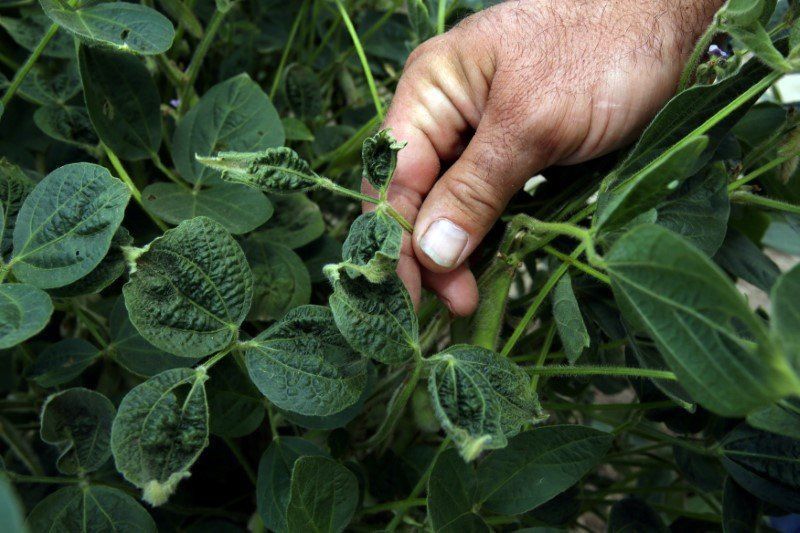When it comes to killing weeds, Bayer crop chemical XtendiMax has become a powerful new tool for American farmers. But environmental groups say U.S. regulators ignored warnings about the herbicide’s main ingredient, dicamba, when they permitted its use in 2016.
A federal appeals court in Seattle was asked Wednesday to overturn the Environmental Protection Agency approval after the unintended destruction of millions of acres of crops not treated with XtendiMax, from wine grapes and peach orchards to vegetables and soybeans. Bayer inherited XtendiMax when it acquired Creve Coeur-based Monsanto Co. for $66 billion in June, and dicamba-based products are key to its growth strategy for herbicides and genetically modified seeds.
Bryce Gray of the Post-Dispatch has covered reports of dicamba-related crop damage since August 2016. Here’s a look at his coverage.
Groups including The Center for Food Safety allege the EPA violated federal law by ignoring evidence from officials in various states that the chemical easily drifted onto untreated crops. In 2017, among soybean farms alone, 3.6 million acres of non-resistant crops were damaged, according to Kevin Bradley, a professor of plant sciences at the University of Missouri. After about 2,700 complaints last year, the EPA required a more detailed product label, mandatory application training, and more rigorous record keeping.
“It’s around in a massive way that’s not getting reported,” said Steve Smith, the director of agriculture at Orestes, Ind.-based Red Gold Tomatoes, the largest privately held tomato processor. “When I drive around the countryside, trees around fields are really showing damage, and that’s not showing up in anybody’s numbers,” said Smith, who is a member of Save Our Crops Coalition, which wasn’t party to the lawsuit. “Everyone had training, so no one can say education is the issue. It’s the product.”
At the hearing on Wednesday, the environmental groups asked the appeals court to invalidate the EPA’s 2016 approval of XtendiMax to make sales illegal.
Many American farmers — especially those who grow corn and soybeans, the two biggest U.S. crops — have become increasingly dependent upon herbicides and seeds that are genetically modified to produced plants that can withstand the chemicals. Monsanto developed the blockbuster weedkiller Roundup in the 1970s, but its effectiveness has waned in recent years as some weeds grew resistant to the active ingredient, glyphosate.
Dicamba-based products are intended to combat the new superweeds, and more are coming. Seeds are being designed with resistance to five or six chemicals. Bayer Chief Executive Officer Werner Bauman, in an Aug. 23 call with analysts, described the glyphosate-dicamba combination, called the Roundup Ready Xtend Crop System, as “our next-generation weed-control system.”
The EPA regulates pesticides and herbicides, which have to be registered with the agency. While permits are reviewed at least every 15 years, the EPA registered new formulations of dicamba for a two-year period to allow the agency to change the registration, if necessary.
The challenge with dicamba is that the chemical can vaporize after it’s applied, which means the air can blow it onto untreated plants nearby. That’s forced some farmers to buy the products defensively, according to the lawsuit. Bradley, the Missouri weed scientist, has said growers will have no choice but to buy seeds with Xtend technology to protect themselves if their neighbors are using the products.
“Bayer wants to double-down on this treadmill where we’re going to have more and more toxic pesticides and cocktails,” said George Kimbrell, the legal director at the Center for Food Safety. Dicamba’s drift problem is “not something farmers can address with label measures,” he said.
At Wednesday’s hearing, Judge William A. Fletcher was critical of the EPA’s 2016 decision, which was based on just two “real world” field studies. One was in Georgia and the other was in Texas, where the data was withheld, he said.
“The only data we have is from one of those two fields,” Fletcher said. “Is that enough? That doesn’t strike me as very much given the great danger that everybody knew dicamba posed to post-emergent fields. It turns out, of course, that the danger was there.”
Brett Grosko, EPA’s lawyer, said that the studies were “sufficient under the standards” and that the court must “allow the EPA to decide” what the best available science is.
Monsanto filed briefs supporting the EPA’s decision-making, arguing farmers need new tools to combat weeds that have grown resistant to Roundup and by 2012 covered more than 60 million acres of U.S. farmland.
“Dicamba-based herbicides have a 50-year history of safe use, when applied according to label directions, and we are confident the government’s exhaustive assessment will prevail,” the company said in an emailed statement.
The court fight comes as the EPA’s approval of dicamba formulations expires Nov. 9, and Bayer expects a renewal decision before then.
Bayer says farmers are adopting its new seeds and herbicide in record numbers. Dicamba-resistant soybeans were planted on 42 million acres in 2018, double the year-earlier total and almost half of the U.S. total of 89.6 million acres, the company said. For cotton, the total was 8 million acres of the 13.5 million acres farmers planted this season.
“We are confident that, in working closely with the EPA, a satisfactory solution for the farmers will be achieved,” Bayer CEO Bauman said on the Aug. 23 call with investors.
The case is National Family Farm Coalition v. United States Environmental Protection Agency and Monsanto Co., 17-70196, 9th U.S. Circuit Court of Appeals (Seattle).
Credit: www.stltoday.com


